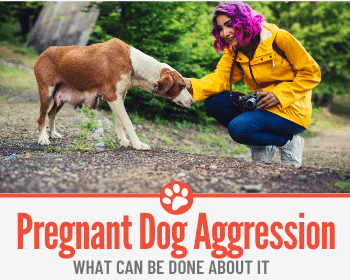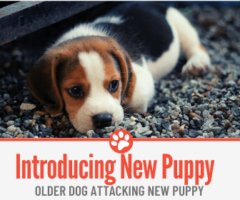 Recently I was over visiting my friend & brought along my four-legged trusty sidekick Cholo to play with her Labrador Bella whilst we had a catch up over some coffee.
Recently I was over visiting my friend & brought along my four-legged trusty sidekick Cholo to play with her Labrador Bella whilst we had a catch up over some coffee.
Unfortunately, Bella, who was six weeks pregnant at the time, surprisingly was not too pleased with the visit! Cholo ran over playfully to greet his old friend but was met with a snarl & bark telling him to back off in no uncertain terms.
‘Sorry about that! She’s been a bit grumpy with other dogs since becoming pregnant’
Anyone with a dog of course knows they all have their own personality. So, was this behaviour just isolated to Bella? Or is this a common trait in dogs who are expectant mothers?
Are pregnant dogs aggressive?
Yes ,Pregnant Dogs can get aggressive, The gestation period is much shorter than humans at around two months. During this time unusual behaviour is common including & even the most placid & loving dogs can exhibit agitation during gestation. If she does you should keep other animals & children at a distance as she is more likely to bite.
Other behavioural changes may include
- A change in appetite: This happens more so in the second half of the pregnancy where she will consume more food than usual
- Lethargy: Less active & playful especially with other dogs. This is both to conserve energy & her mother instinct to protect her soon to be pups. The first couple of weeks she will be her usual self.
- Nesting: Looking for a comfortable place to rest & give birth. Scratching at the ground & moving her bed is common at this stage.
- Clinginess: Expect her to be following you everywhere about the house, loads of cuddles & of course the big sad eyes!
- ‘’Morning sickness’’: The canine equivalent will occur in the early stages of pregnancy
Behaviour of male dogs around a pregnant female
Behaviour will in most part be completely normal with no change. Some may ‘know’ she is pregnant due to them sensing her change in hormones & develop somewhat of an affixation with her rear behind.
Towards the end of the pregnancy it is best to keep her separated from male dogs completely. Of course, this is also the case when she is in heat.
Physical changes will not be visible for several weeks when your dog is pregnant. When they do occur, you may notice:
- More prominent colour in nipples should be noticeable after four weeks & sometimes they will discharge a semi clear fluid
- Discharge of mucus after thirty days since mating
- Enlarged breasts usually occur around the same time the belly swells but sometimes this happens in the first couple of weeks
- Weight gain will be visible around week five of the pregnancy
- Vaginal discharge & urinating more frequently due to having less space & the pressure on the bladder
- Swollen tummy around week 6
Phantom pregnancy (Pseudocyesis) is a common occurrence in unspayed females where they exhibit all the tell-tale signs of pregnancy both physically & sometimes mentally. This occurs usually around six to twelve weeks after her last heat cycle. The suspected cause of this is due to fluctuations in her hormonal system, specifically where progesterone primarily decreases & prolactin increases. Most dogs will pass this after 2-3 weeks & return to their usual selves.
Will my vet not be able to tell me if it is a real pregnancy?
Usually a vet checks her hormonal levels at around 21-25 days to find out if she is pregnant. The dog should be out of her phantom stage by this point if that is indeed the case
Female Dog in Heat Behaviour
A female dog in heat will go through four stages in her cycle. The first stage (proestrus) usually lasts around 9 days and she may exhibit the following behaviour:
- Aggressive towards humans & other dogs. The excess hormones will alter her mood with her estrogen levels sharply rising. At this stage she will be unwilling to mate with male dogs & may become aggressive if they try to mount her.
- Licking her genital area excessively.
- Change in appetite: This can vary either way. may be distracted thinking about something else causing her to consume less food but she will need more due to her increase in energy
- Restlessness is common although sometimes they may be quite lethargic.
- Enlargement of the vulva: The cells in her uterus will grow when she’s in heat & may be noticeable
- Mounting both male & female dogs & even humans!
The second stage of the cycle (Estrus), sometimes referred to as the ‘real heat’ due to her ovaries beginning to release & her symptoms going into Defcon 5 mode! Typical behaviour changes:
- Down to Boogie! Compared to the first stage she is much more receptive to male attention & will show her rear with the tail pushed to the side
- Colour change in discharge: A pinkish fluid will now extrude rather than the red as before.
- More restlessness: Lack of sleep, howling & barking excessively
- More peeing! This lets other dogs know she is in heat
The third stage (Diestrus) can last 60-90 days is when the dog is no fertile. If she was impregnated this stage will last from the end of the Estrus stage until the birth of the pups. Approximately 60 days.
The fourth stage (Anestrus) also known as the ‘resting stage’ is the final one & lasts 100-150 days until the next cycle
What age will my dog first go into heat?
A female dog who has not been spayed will usually have her first season at around 6 months of age. A few of the larger breeds may be a bit older, up to 12 months.
How long will her cycle be?
Typically, she will be in heat anywhere from 2-4 weeks & unlike humans they will continue to do so approximately every 6 months throughout their lives.
How to Calm a Dog in Heat
When your dog is in heat this can be a stressful time, not only for your pooch but you too! Younger females are more prone to exhibit the symptoms as they are experiencing it for the first time. Thankfully, there is a few methods you can use to reduce their anxiety & calm them down.
‘Run Forrest Runnnn!’: Burn their excess energy off & give them plenty of exercise. Jog, fetch, swim etc. This in turn, will cause them to sleep more & not be in a stressed state. Use precaution when out & DO NOT let them off leash unless you are somewhere with no other dogs in sight.
Mental stimulation: A great way to keep their minds occupied & studies have shown playing games with a dog can tire them out as much as exercise. Perfect for those rainy days!
Toys: The chewier the better! Dogs love to chew when they are stressed, plenty of toys is one way to keep them happy.
Menthol: A slight dab on her tail can help hide her scent from other dogs
Hopefully at least one of the methods above is useful to you.
If you are not planning on breeding your female dog, having her spayed may be the best option. This reduces the risk of certain illnesses & cancers. Not to mention, having to fend off all those randy dogs.






